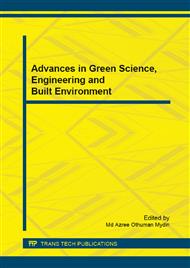[1]
Bianchini, F., & Hewage, K. (2012). Probabilistic social cost-benefit analysis for green roofs: A lifecycle approach. Building and Environment, 58, 152-162.
DOI: 10.1016/j.buildenv.2012.07.005
Google Scholar
[2]
Theodosiou, T. G. (2003). Summer period analysis of the performance of a planted roof as a passive cooling technique. Energy and Buildings, 35(9), 909-917.
DOI: 10.1016/s0378-7788(03)00023-9
Google Scholar
[3]
Kosareo, L., & Ries, R. (2007). Comparative environmental life cycle assessment of green roofs. Building and environment, 42(7), 2606-2613.
DOI: 10.1016/j.buildenv.2006.06.019
Google Scholar
[4]
Kortright, R. (2001). Evaluating the potential of green roof agriculture. City Farmer. Report on MSc Thesis, Trent University, Canada. Available at http: /www. cityfarmer. org/greenpotential. html.
Google Scholar
[5]
Gómez-Limón, J., &Fernández, J. V. D. L. (1999). Changes in use and landscape preferences on the agricultural-livestock landscapes of the central Iberian Peninsula (Madrid, Spain). Landscape and Urban Planning, 44(4), 165-175.
DOI: 10.1016/s0169-2046(99)00020-1
Google Scholar
[6]
Zube, E. H., Sell, J. L., & Taylor, J. G. (1982). Landscape perception: researchapplication and theory. Landscape planning, 9(1), 1-33.
DOI: 10.1016/0304-3924(82)90009-0
Google Scholar
[7]
Fernandez-Cañero, R., Emilsson, T., Fernandez-Barba, C., & Herrera Machuca, M. Á. (2013). Green roof systems: A study of public attitudes and preferences in Southern Spain. Journal of environmental management, 128, 106-115.
DOI: 10.1016/j.jenvman.2013.04.052
Google Scholar
[8]
Lee, K. E., Williams, K. J., Sargent, L. D., Farrell, C., & Williams, N. S. (2014). Living roof preference is influenced by plant characteristics and diversity. Landscape and Urban Planning, 122, 152-159.
DOI: 10.1016/j.landurbplan.2013.09.011
Google Scholar
[9]
Dvorak, B., & Volder, A. (2010). Green roof vegetation for North American ecoregions: a literature review. Landscape and urban planning, 96(4), 197-213.
DOI: 10.1016/j.landurbplan.2010.04.009
Google Scholar
[10]
Berndtsson, J. C., Bengtsson, L., &Jinno, K. (2009). Runoff water quality from intensive and extensive vegetated roofs. Ecological Engineering, 35(3), 369-380.
DOI: 10.1016/j.ecoleng.2008.09.020
Google Scholar
[11]
Hussin, K., & Raid, M. M. (2013). The Assessment of Rooftop Garden in Green Building Index (GBI). In 4th International Conference on Business and Economic Research (4th icber 2013) Proceeding. Bandung, Indonesia.
Google Scholar
[12]
Rowe, D. B., Getter, K. L., & Durhman, A. K. (2012). Effect of green roof media depth on Crassulacean plant succession over seven years. Landscape and Urban Planning, 104(3), 310-319.
DOI: 10.1016/j.landurbplan.2011.11.010
Google Scholar
[13]
Liu, K. (2004). Sustainable Building Envelope–Garden Roof System Performance. In RCI Building Envelope Symposium, New Orleans, Louisiana.
Google Scholar
[14]
Getter, K. L., & Rowe, D. B. (2006). The role of extensive green roofs in sustainable development. Hort Science, 41(5), 1276-1285.
DOI: 10.21273/hortsci.41.5.1276
Google Scholar
[15]
Grammatikopoulou, I., Pouta, E., Salmiovirta, M., &Soini, K. (2012). Heterogeneous preferences for agricultural landscape improvements in southern Finland. Landscape and Urban Planning, 107(2), 181-191.
DOI: 10.1016/j.landurbplan.2012.06.001
Google Scholar


